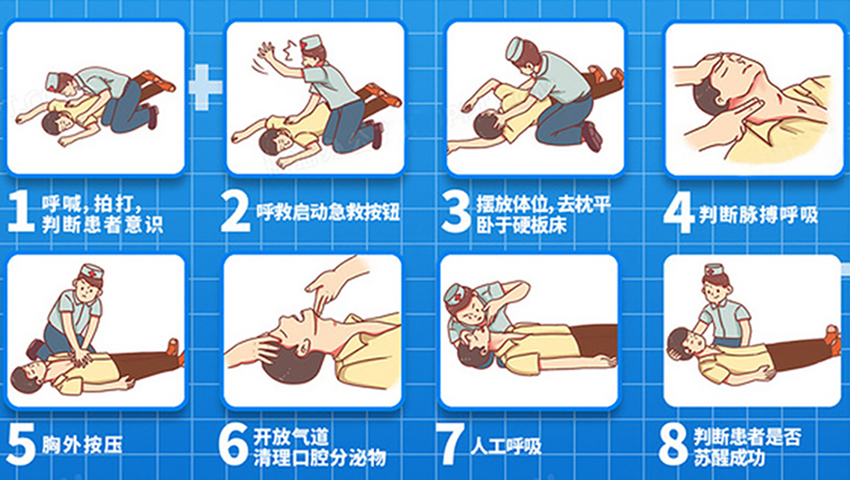Increase campus AED deployment rates and CPR prevalence rates
During the 2024 National People's Congress, Ao Hushan, a member of the National Committee of the Chinese People's Political Consultative Conference (CPPCC), a member of the Proposals Committee, the executive vice president and corporate secretary general of the Chinese Society of Cardiothoracic and Vascular Anesthesiology (CSCVA), and the director of Fu Wai Hospital of the Chinese Academy of Medical Sciences (FWH-CAMS), submitted the proposal of “Paying attention to the problem of cardiac arrest on campuses, and improving the rate of AED deployment and CPR prevalence on campuses.
I. Importance of AED Configuration and CPR Skills
Sudden cardiac arrest is one of the main causes of sudden cardiac death, which has a high rate of death and disability. According to the China Sudden Cardiac Arrest and CPR Report (2022 Edition), there are more than 750,000 cases of cardiac arrest in China each year that are seen by EMS (Emergency Medical Services), and the survival rate of patients discharged from the hospital is only 1.2%. The optimal emergency time for out-of-hospital cardiac arrest is only about 4 minutes, and timely CPR and defibrillation with an AED (automated external defibrillator) can greatly reduce mortality and disability.
By the end of 2022, China's nationwide AED allocation rate is about 15 units per 100,000 people, but compared with the developed countries equipped with 200-300 units per 100,000 people, there is still a big gap. According to some data, in 2023, the scenes where AEDs are used more frequently in China are schools, public transportation places (e.g., subway stations, train stations, airports), sports venues, streets and communities. Therefore, configuring AEDs in the above places and strengthening CPR training are of great significance to save patients' lives.
Second, the popularity of campus first aid equipment and technology is becoming more and more important
With the increasingly serious dependence on electronic products, reduced exercise, increased learning pressure, diet and other lifestyle changes, cardiac arrest incidence has a younger trend. Campuses are densely populated, sports venues are concentrated, is the focus of the high incidence of cardiac arrest. 2022-2023, according to the series of the Red Cross Society of China's peace of mind project statistics, the AED configuration of its region occurred in 20 cases of cardiac arrest in 11 cases on campus, accounting for 55%. At present, the CPR prevalence rate and AED configuration rate of teachers and students in China's large, middle and elementary school campuses are low, so the popularization of first aid on campuses is becoming more and more important.
Third, improve the popularization rate of CPR and AED configuration rate on campus and suggestions
First, encourage the participation of social forces to improve the rate of AED configuration on campus. Through social organizations to set up public fundraising charitable projects, mobilize social caring enterprises, caring people, AED manufacturers, etc. to donate AED equipment to key areas of the campus.
Second, to promote the implementation of standardized norms for the management and maintenance of campus AED devices. As a medical electronic device, the service life of AED electrode pads and internal batteries is generally 3~5 years. Schools are often equipped with AEDs that cannot be used due to timely maintenance and repair, and in case of emergencies, they are useless. Therefore, it is recommended to formulate the relevant standards for the maintenance, overhaul, renewal and other management measures of campus AED equipment to ensure that campus AED equipment can play its due role.
Third, improve the quality and efficiency of campus CPR training. In recent years, the state has repeatedly issued documents requesting to increase emergency rescue training for school teachers and students. However, the reality is that most of the students and teachers observe the instructor's demonstration and practice less hands-on, resulting in many teachers and students only know about it, and do not really master CPR techniques. Therefore, campus CPR should focus on effectiveness, every teacher and student should know the knowledge of CPR, repeated practice and really master the CPR technology, while the training should focus on assessment and retraining.
Fourth, focusing on campuses in underdeveloped areas such as counties to promote the sinking of first aid resources. Compared with big cities, medical and first aid resources in counties are more scarce, AED configuration is less, and people's awareness of first aid is weaker. Therefore, it is necessary to promote the sinking of first aid resources, strengthen the configuration of AEDs on campuses in such areas, and encourage first aid instructors from large cities to go down to the grassroots level to carry out first aid training on campuses at the grass-roots level, so as to narrow the regional differences, make up for the shortcomings, and promote the rate of configuration of AEDs on campuses in China, as well as to increase the overall popularity rate of CPR.



